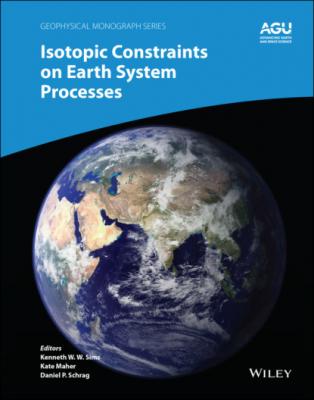Isotopic Constraints on Earth System Processes. Группа авторов
Чтение книги онлайн.
Читать онлайн книгу Isotopic Constraints on Earth System Processes - Группа авторов страница 35
 C slash upper C Subscript e Baseline right-parenthesis comma"/>
C slash upper C Subscript e Baseline right-parenthesis comma"/>
which leads to the one‐dimensional diffusion equation (Eq. 9a in Zhang, 1993):
where the units of concentration may be in weight percent if density can be assumed to be constant. The reason for the approximation symbol in equation 2.5 is that Zhang (1993) uses equation 2.8 to calculate concentration profiles and then calculates activity profiles from the relation a = kC/Ce, where k is the proportionality constant between Ce and 1/ γ . A point that was nuanced by Zhang (1993) is that equations 2.5 and 2.7 are not equivalent, but rather are scaled by a factor k, which can be determined from the constraint that a = C at x = 0 (interface).
Figure 2.5 The Zhang model and its parameters are based on the concept of elemental partitioning in an SiO2 gradient. The initial concentration distribution is C+ for x > 0 and C− for x < 0. At equilibrium, the concentration contrast may be reversed (depending on the sign of Cf) such that C+, eq for x < 0 and C−, eq for x > 0.
Model Validation and Behavior
The Zhang (1993) model deviates significantly from the EBD model when the component of interest diffuses significantly faster than SiO2. In this situation, which is common in silicate liquids, the component of interest will not reach homogeneity quickly, but rather, will partition along the compositional continuum between the high‐ and low‐silica liquids and reach compositional homogeneity only as fast as SiO2 diffuses.
The behavior of the model is shown in Fig. 2.6 for an infinite diffusion couple where the initial concentration gradient is small and
Figure 2.6 Model behavior showing concentration, activity, and transient equilibrium concentration profiles for C− = 6 wt%, C+ = 8 wt%,
Model Applied to the Rhyolite‐Phonolite Couples
The rhyolite‐phonolite diffusion couple spans a broad range of melt compositions. Although the diffusion coefficients are expected to be sensitive to melt composition across this range, we assume
Despite the many simplifying assumptions that are needed to distill a general multicomponent diffusion problem down to a three‐parameter model (Cf, Db, and
The goodness‐of‐fit for the K2O profile is even less satisfying due to the unusual shape of the measured K2O profile, which is nearly flat on the mafic side and linear to nearly convex on the felsic side. This shape cannot be reproduced using the simplified EBD models discussed herein. Nevertheless, the inferred